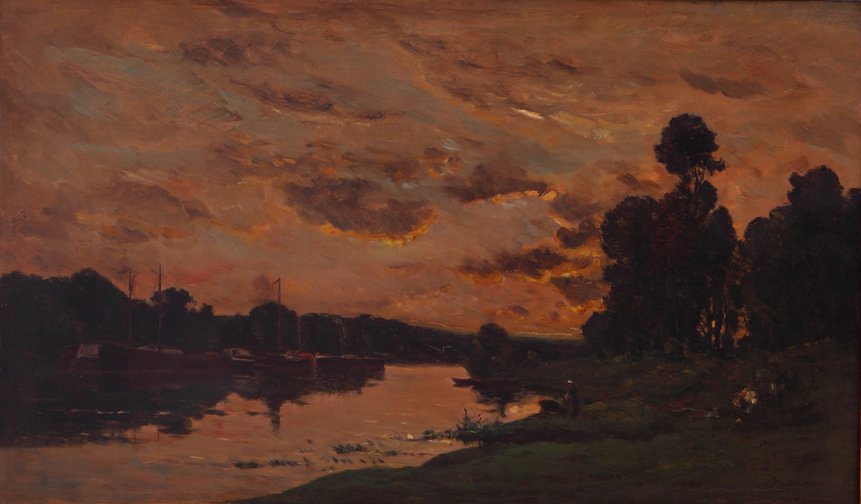
La tarde (The afternoon)
Daubigny, Charles-François.
More informationabout the work
Masterpiece
Accession Number 2481
Exhibited work
"Museo secreto. De la reserva a la sala" - Pabellón de exposiciones temporarias
In the luminous atmosphere of a sunny day, the leader of a troupe of traveling musicians has gathered a small group of women and children in the street, while the latter even venture a few improvised dance steps. In reference to In attesa degli sposi (Waiting for the Bride and Groom), a painting replicated several times between 1879 and 1883, Giuseppe Pavanello wrote that it was “an extraordinary image of Venetian life, taken from reality”; it also has sufficiently close stylistic and compositional parallels with the Musici ambulanti (Traveling Musicians) paintings to allow it to be fairly considered as an immediate predecessor (1).
As is the case in the paintings mentioned, in our example a young man standing on a gondola at rest in the canal observes the scene. His attitude suggests curiosity and at the same time detachment, the same disposition of thought and spirit with which the artist approached such a carefree scene, enjoying its sense of cordial humanity albeit quite aware of how different his destiny was. This condition was common among many Italian artists from the late 1870s, a moment when they sought to find a suitable manner of expressing society’s concerns at the time, moving away from themes derived from everyday reality. They turned to a texture impregnated with tensions, full of tremors and vibrating with light, thus renovating meanings on the most intimate level, conjugating compositional schemes with impeccable spatial constructions. This is what takes place in Musici ambulanti, where Favretto sets loose an innovative pictorial ductus, combined with the rigor of a spatial composition that is perfectly balanced and rhythmic in depth, thanks to the figure of the gondolier who is seen from behind in the foreground and thus draws us into the painting’s narrative. The image is the product of the artist’s reflections on the great models of 18th Century Venetian tradition, and on the vivid, vaporous chromatic scheme of Giovanni Battista Tiepolo in particular.
The captured reality that Pavanello makes reference to does not consist of representing a fragment of contemporary life, but in the artist’s ability to imbue the captivating themes of genre painting with a sense of inherent and atmospheric “truth” by way of wise elaboration of pictorial materials. It is no coincidence that in his comments on the paintings which Favretto presented at the Esposizione Nazionale del 1881 in Milan Luigi Chirtani, a sharp, brilliant critic highlighted their originality, due especially to the painter’s mastery in expressing “the artistic manner in which the real left its impression on him”; a sensibility that allowed him to capture “the elegance in light” and intonations of color, from which he was able to extract infinite gradations that also make use of the colorful support, thus “achieving the appeal present in all his paintings” (2).
The Venice that this artist loved was not monumental Venice, but the city of back alleys, rivers, arcades and time-weary walls impregnated with the signs of lasting existence. During the early ‘80s, he managed to create moving and original interpretations of that city, deserving of the opinion that accompanied the reproduction of the Musici ambulanti in the Buenos Aires magazine Athinae in January of 1910: “The personal stamp of the Italian maestro’s talent can be found in his interpretation of Venetian themes. The subtle colors of his palette transform his genre paintings into joyful notes” (3).
At that time, the painting had already been part of the MNBA collection for several years, acquired when its owner, Aristóbulo del Valle passed away in 1896. A famous lawyer committed to the life of his country, del Valle cultivated his interest in literature and art with great passion, which led him to undertake an extensive voyage to Europe in 1884. In Venice in 1885, painter Augusto Ballerini introduced him to Giacomo Favretto’s studio; he fell in love with Musici ambulanti and decided to acquire it even at great sacrifice, given the elevated price of the work (4). In order to better appreciate the painting along with others that he considered to be his collection’s most valuable—among others Femme et taureau (Woman with Bull) by Roll and Floréal by Raphaël Collin—del Valle renovated a room in his own home, fitted with a glass roof in order to illuminate the paintings in the best and most homogenous way possible (5).
1— Nico Stringa, 2004, p. 250, nº 64.
2— Luigi Chirtani, “A Palazzo di Belle Arti-I veneziani” in: Milano e l’Esposizione Nazionale del 1881. Cronaca illustrata dell’Esposizione Nazionale Industriale ed Artistica del 1881. Milano, 1881, p. 142.
3— “Galería de Athinae”, 1910.
4— Belisario J. Montero, 1922, p. 223.
5— María Isabel Baldasarre, 2006, p. 167.
1910. “Galería de Athinae”, Athinae, Buenos Aires, a. 3, nº 17, reprod. byn.
1922. MONTERO, Belisario J., Ensayos sobre filosofia y arte (de mi diario). Buenos Aires, p. 223-224.
1999. TREVISAN, Renzo (cur.), Giacomo Favretto 1849-1887. Scorzè, La Tipografica, p. 147.
2004. STRINGA, Nico y Giuseppe Pavanello (cur.), Ottocento veneto. Il trionfo del colore, cat. exp. Treviso, Canova, nº 64, p. 250.
2006. BALDASARRE, María Isabel, Los dueños del arte. Coleccionismo y consumo cultural en Buenos Aires. Buenos Aires, Edhasa, p. 164-165, 237, reprod. color nº 70.
Related works
A vast panorama of Argentinean art, including works by its greatest representatives
Browse collection ›Get to know the great works on exhibit, and more
Browse collection ›